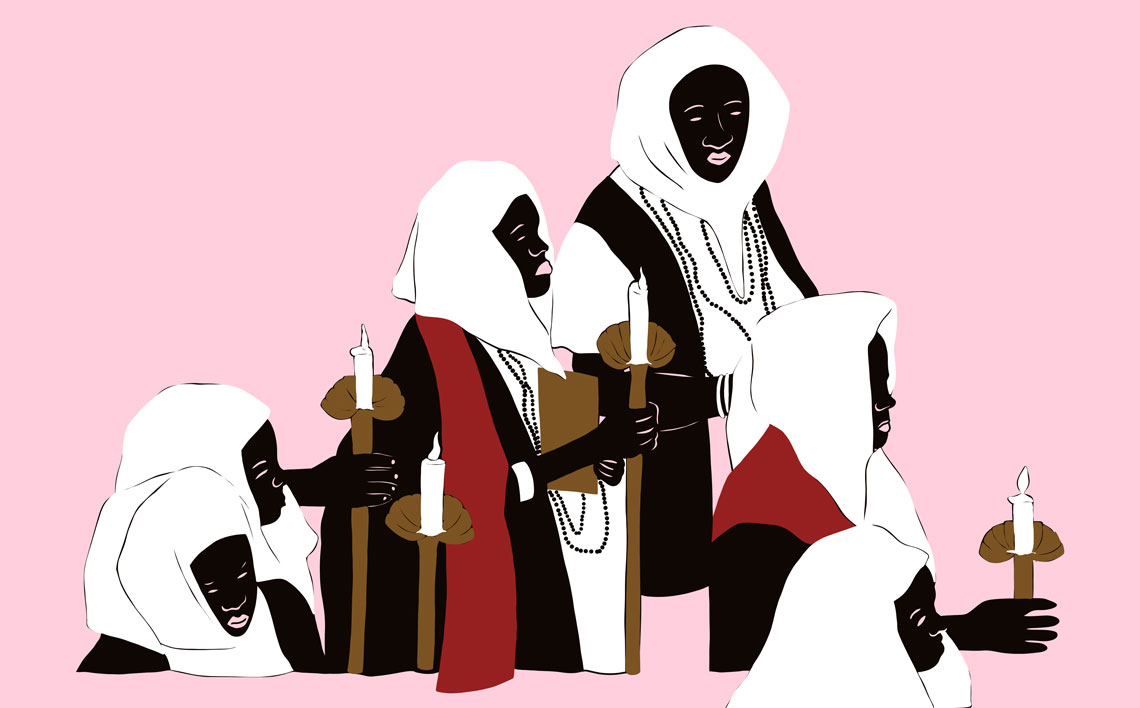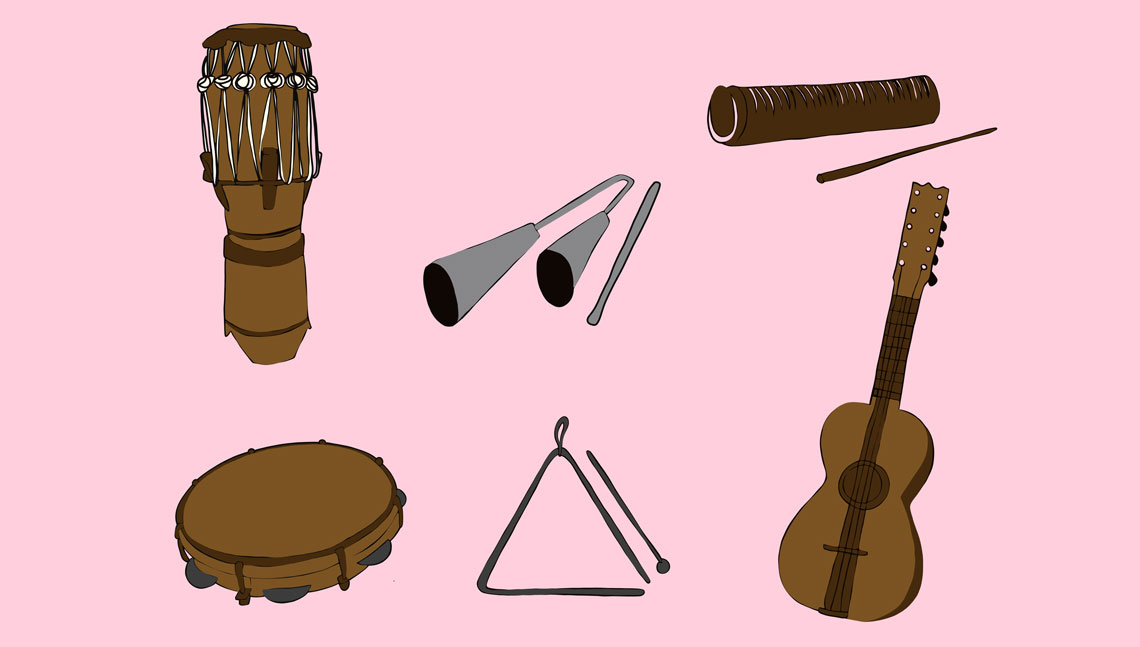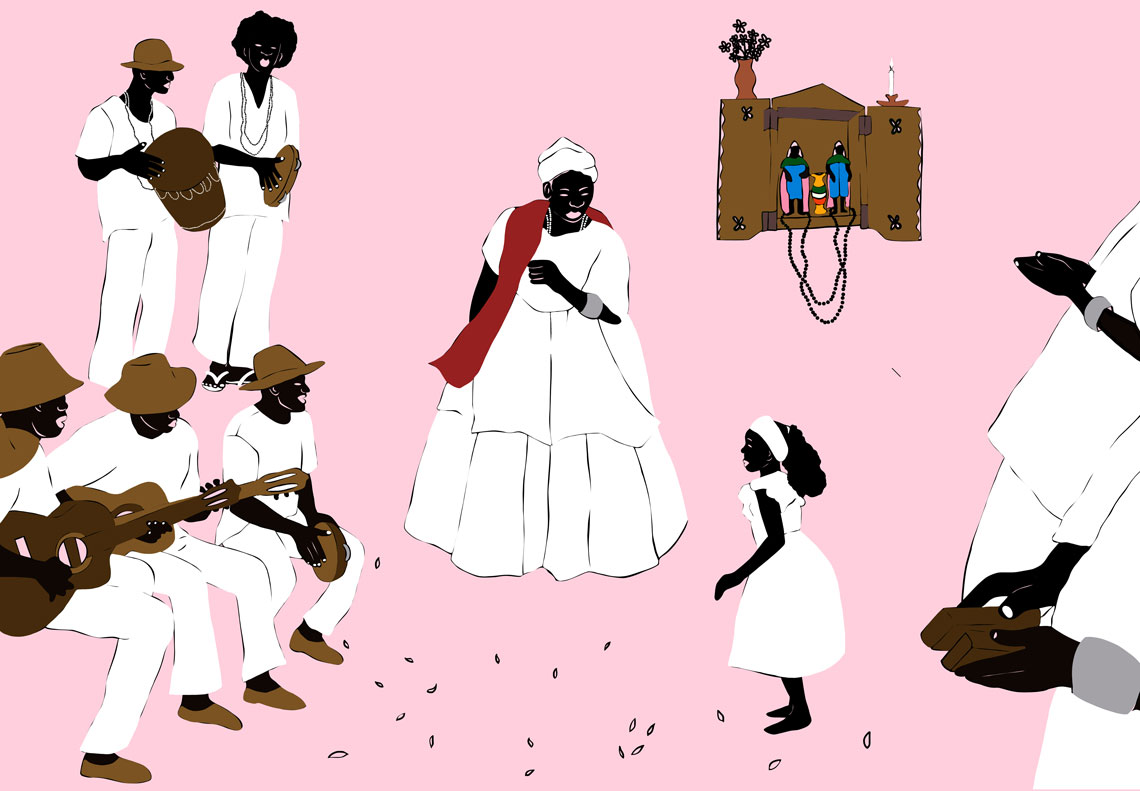“‘What time is it?’ someone asked. ‘It’s 6:40 pm; shall we start?’ At that point, the 10 women formed a halfmoon in front of the altar. Dona Creuza was closer to the altar, along with her two cousins, each of them holding their prayer book in their hands; although almost everyone knew the liturgy by heart. The three women in the front row led the novena. The novena started in unison, with everyone making the sign of the cross. Then it ended with a few short prayers, hands clapping and ‘vivas’ on behalf of the saint, the birthday person, and the participants. Little by little, the hand clapping turned into a samba rhythm, and everyone started to sing the Saint Cosmas and Saint Roque chants.”
The story above was told by the American ethnomusicologist Michael Iyanaga in his recently published book Alegria é devoção – Sambas, santos e novenas numa tradição afro-diaspórica da Bahia (Joy is devotion – Sambas, saints, and novenas in Bahia’s afrodiasporic tradition). The book is the unfolding of the researcher’s doctoral thesis defended in 2013 at the University of California, Los Angeles (UCLA), and it speaks to the household tradition of singing and dancing samba songs in the Recôncavo Baiano region. In his work, the author discusses the altar, the novena (which in this case is a single-night event), and the samba de roda (samba in a circle of people), all elements found in this type of home-based celebration, and also makes available six recordings of ceremonies, which can be accessed using a QR Code. “The prayer service is usually held on the saint’s day, designated by the Catholic Church, or on a close date, but this is not a rule,” explains Iyanaga, who is currently a professor at the College of William & Mary in Virginia.
Iyanaga went to Brazil for the first time in 2002 and, four years later, took courses at the Federal University of Bahia (UFBA). Since then, his time spent in the country “has been quite diversified,” says the author. The researcher lived in Bahia between 2006 and 2007, and later, between 2012 and 2014, when he also spent some time in Recife (Pernambuco). In 2016 and 2017, he was a professor at the Federal University of the Recôncavo Baiano (UFRB). “Now I spend almost half the year in Bahia,” he adds. His interest in the subject matter of the study began by chance in 2008, when he joined a prayer session, invited by the samba de roda group “Filhos de Nagô,” in the Recôncavo. “The house was crowded with people and there was a lot of music playing. I was delighted and curious about that celebration. This is how the research began,” he stated.
One of the main findings of his study, detailed in the book, was showing how this tradition of Catholic inspiration, usually a practice of the Black population of the Recôncavo Baiano, is part of the African diaspora. That is, it arrived in Brazil with the forced transatlantic immigration of Africans, during the times of slave trafficking, from the sixteenth to the nineteenth centuries. The field studies carried out by Iyanaga indicate that the religious contribution of the enslaved Africans in Brazil is not limited to practices such as the worshipping of orishas. “The prayers at the Recôncavo are also part of Brazil’s religious African heritage, because part of the roots of this variation of Catholicism are in Africa,” advocates the researcher.
 Mayara Ferrão
Mayara Ferrão
Iyanaga’s argument is based on studies of American historians, such as John Thornton and Cécile Fromont, who mention the existence of Catholicism in central Africa since the end of the fifteenth century, in other words, before the arrival of the Europeans on the American continent. In accordance with these studies, in 1491, the Catholic Church was officially introduced in the former Congo, a region that nowadays corresponds to the border between Northern Angola and the current Democratic Republic of the Congo, when Nzinga a Nkuwu, then Congolese monarch, agreed to be baptized. Later, his son Mvemba a Nzinga, who governed the Congo from 1506 to 1545 under the Lusitanian name Afonso I, in addition to the celebration of religious feasts, ordered the construction of churches and the foundation of brotherhoods and sisterhoods. “As pointed out by Thornton and Fromont, throughout the sixteenth century, Catholicism began to influence the entire society in the Congo, as well as people in the neighboring regions,” says Iyanaga. “But he never entirely imposed the traditions of ancient Congo, and a new Catholicism began to take shape, based on ritual, esthetic, and cosmologic components originating from local traditions.”
According to the researcher, this is evidence that Catholicism was already significantly present in that region of Africa when the local people started to be enslaved and transferred in significant numbers to Brazil, as of the end of the sixteenth century. “Approximately 45% of the enslaved Africans on the American continent originally came from Central Africa and spoke the Bantu language. Historian James Sweet mentions that more than 90% of those brought to Brazil until approximately 1680 were originally from that region,” says Iyanaga. “In other words, part of the Central-African people introduced to Brazil what they already knew and practiced in their own Congolese Catholicism.”
Survey identified 11 samba groups exclusively formed by children, many of whom participate in the prayers at home
According to Iyanaga, the samba, whose roots are Central-African, and its historical predecessors, such as the umbigada and the batuque, were developed in Bahia, along with the worshipping of the Catholic saints. “During the seventeenth century, for example, the Bahian poet Gregório de Matos [c. 1636–1696] wrote about the mestizo woman who receives several umbigadas (being hit by someone else’s belly) when dancing in the Our Lady of Guadalupe festival in Bahia,” asserts the researcher.
Another example of this connection between samba and Catholicism, states Iyanaga, is the letter sent by the Black sisterhood Gloriosa Senhora do Rosário da Cidade da Bahia to Queen Mary I (1734–1816) in 1786. Among other things, the letter requested authorization to perform “dancing in the Angolan language.” “Although it is difficult to know exactly what these dances actually were, about one century later, the Portuguese traveler Alfredo de Sarmento stated that a circle dance quite similar to Bahia’s samba was commonly seen in Angola,” reports the ethnomusicologist.
During his doctoral research, between 2008 and 2013, Iyanaga observed about 40 prayers at the Recôncavo Baiano, mostly in the municipalities of Cachoeira and São Félix. “Each prayer is different, and the names also vary. In addition to ‘prayers,’ they may also be called, for example, novenas, penances, sambas, or carurus. The latter is a reference to the okra caruru, a typical Bahian dish that used to be served to guests,” reports the researcher. The common denominator is the samba, which usually opened and closed the gatherings. “The belief is that the more samba there is, the happier the people will be, and this collective joy will make the saint even happier,” explains Iyanaga.
 Mayara Ferrão
Mayara Ferrão
According to the researcher, samba is not only part of the religious celebrations that happen within the households of the Recôncavo Baiano. An example of this is the Boa Morte e Glória (good death and glory) celebration that takes place every year during the second half of August, in the city of Cachoeira. “Since the nineteenth century, this event has been promoted by the Sisterhood of Our Lady of Good Death, which is comprised of women, many of whom are elderly, Catholic, and those who practice Candomblé,” shares the ethnomusicologist Francisca Helena Marques, professor at UFRB and author of a doctoral study about the festival, which she defended in 2009 at the School of Philosophy, Languages and Literature, and Humanities at the University of São Paulo (FFLCH-USP).
For three days, public processions and banquets take place to celebrate the assumption of Our Lady into heaven. The end of the festival includes samba music, initially performed in a public area and later on private grounds, at the headquarters of the sisterhood. “During this ritual, samba symbolizes the passing from death to the joy of living. Samba is freedom,” observes Marques, head of the Ethnomusicology, Anthropology and Audiovisual Laboratory (LEAA/Recôncavo-UFRB), certified by the Brazilian National Council for Scientific and Technological Development (CNPq).
In 2019, the LEAA/Recôncavo-UFRB and the Association of Samba Dancers of the State of Bahia (ASSEBA) mapped out 121 samba de roda groups established not only in the Recôncavo, but also in the metropolitan region of Salvador and in the Portal do Sertão, a territory that encompasses an area of almost 6,000 square kilometers and composed of 17 municipalities, including Feira de Santana. The research was carried out to revalidate the title granted to the samba de roda as a Cultural and Intangible Heritage of Brazil, in October 2004, by the National Institute for Historical and Artistic Heritage (IPHAN). It is worth noting that, in November 2005, the United Nations Educational, Scientific and Cultural Organization (UNESCO) classified the manifestation as a Masterpiece of the Oral and Intangible Heritage of Humanity. The work performed by the LEAA/Recôncavo-UFRB and by ASSEBA, whose researchers were the samba artists themselves, was compiled in a documentary and a book published in 2021.
According to guitar player, biology teacher, and endemics enforcement agent Alexnaldo dos Santos, chairman of ASSEBA, the domestic Catholic festivals powered by samba de roda are beginning to disappear from the Recôncavo. “They still happen, but at a lower frequency than before. In the past 15 years, several masters and folk healers have died, not to mention the fact that so many people became evangelical and no longer celebrate the saints in this manner,” concludes the 47-year-old samba artist, who began participating in the prayers at an aunt’s home when he was still a child. But there is hope that the ritual will not disappear. “Our survey allowed us to identify 11 samba groups exclusively formed by children, many of whom participate in the prayers at home. In my understanding, this is a sign that this tradition will not die, at least not in the Recôncavo,” he concludes.
Books
IYANAGA, M. Alegria é devoção – Sambas, santos e novenas numa tradição afro-diaspórica da Bahia. Campinas: Editora da Unicamp, 2022.
MARQUES, F. H. (org.). Samba de roda, patrimônio da humanidade – 15 anos de salvaguarda e conquistas. Santo Amaro da Purificação: ASSEBA, 2021.


